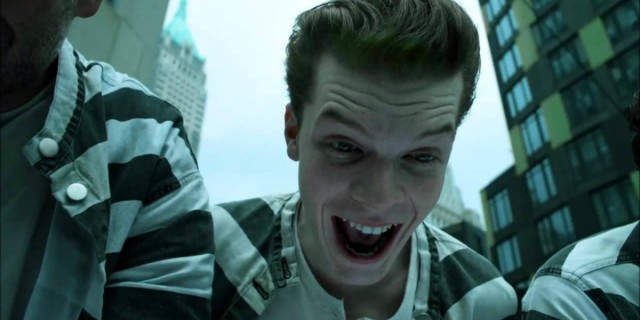NOTE: Spoilers from throughout the second season of “Gotham” are present in this review
Gotham saw a handful of improvements in its second season, resulting in a season that still wasn’t perfectly airtight with its storytelling, but was at least a little more consistently exciting and fun than Season One could be. With the introduction of great new villains like Hugo Strange, and a more dark and personal journey for Jim Gordon, Gotham is edging closer to the outstanding pedigree of most Batman-themed media, even if it still has a little ways to go to truly get there.
With the mobs of Gotham City mostly decimated after the events of Season One, Season Two shifted focus to developing more personalized criminal identities for the city. This was accomplished with a specially-titled front half and back half of the season, with the season’s front half episodes being dubbed the, “Rise of the Villains” arc, while the back half of the season was dubbed the, “Wrath of the Villains” arc. It goes to show where Gotham’s focus was most during Season Two, and as much as Gordon was still effectively put through the emotional ringer, the villains were often the star of the show this season, as you could expect.
In the front half of the season, Gordon was placed against Theo Galavan, the favoured son of a secret sect of Gotham City’s underbelly called the Order of St. Dumas, which sought to reclaim the city from the wealthy families that previously pushed the Dumas family out. The conflict began on a solid note, and the sibling duo of Theo and Tabitha Galavan were initially promising villains, though they were also overshadowed by their initial plan, a great Joker-foreshadowing villain group called The Maniax, which included Jerome Valeska and Barbara Kean. The Maniax were fun and memorable characters, which is why it’s a shame that they were obliterated early in the season, with Jerome even being killed off. Barbara, meanwhile, was banished to Arkham Asylum after an encounter with Gordon leaves her comatose, with the show going back-and-forth on whether she’s a true villain, or simply a misunderstood victim of circumstance. Either way, Barbara at least got more interesting this season.
Over time though, the Galavan siblings did somewhat lose their appeal a bit, especially since the season often didn’t know what to do with Tabitha, who is supposed to double as a loose re-invention of DC Comics villainess, Tigress. The moment where Gordon finally kills Theo Galavan in the midseason finale, forsaking legal justice for his own personal justice, was pretty great, and it did set up Theo to be revived later and briefly return as the forerunner to another recognizable DC Comics villain, Azrael, though in the season’s front half, Gordon’s journey stood out more than Theo Galavan. Gordon’s relationship with Leslie Thompkins was a big part of this, with the two even deliberating leaving Gotham City after Leslie becomes pregnant, though after Gordon is briefly incarcerated for his murder of Theo Galavan, Leslie just kind of disappears, and is mostly forgotten about for the rest of the season. She even loses the baby off-screen, which feels like annoying back-pedaling on what was otherwise a fairly interesting deviation from DC Comics canon, where Barbara Kean serves as mother to Gordon’s children.
The “Wrath of the Villains” arc was pretty evidently the stronger of the two in Gotham’s second season, especially since it introduced one of the show’s best Batman villain representations yet, Hugo Strange. Strange’s presence builds on an Arkham Asylum plot that was foreshadowed in Season One, and subsequently abandoned, before Season Two picked it up again. The wait was worth it though, as Strange’s menacing intelligence and twisted, amoral experiments finally gave Gotham a worthy enemy to place at Gordon’s feet, especially when the GCPD are predictably no help.
Speaking of the GCPD, the Maniax arc made for another major deviation from DC Comics canon, when Sarah Essen, Gordon’s initial captain in this show and future second wife in the printed panels, is killed off by Jerome, leading to her being replaced by Captain Nathaniel Barnes, an original new character not present in DC lore that was invented for Gotham. Barnes’ uncompromising, hardline stance on crime in Gotham City made him an unpredictable ally or nemesis to Gordon, depending on where Gordon’s investigation against his foes stood, and he made for a pretty strong contrast to Gordon’s more morally murky portrayal this season. Barnes often represented the letter of the law when Gordon had to face bending and breaking the rules to bring down the villains, and while his fate at the end of the season is unknown, after he’s stabbed by Azrael and left in critical condition, he ultimately ended up being a more interesting captain for the GCPD than Essen ever was.
Speaking of bending the law, Bruce Wayne also improved immensely this season, especially in the back half, as he continues to mature, and poke ever deeper into his company’s sordid secrets. There were some big moments for Bruce this season, including directly facing down his parents’ killer, Matches Malone (yet another deviation from DC lore, where Joe Chill is the Waynes’ killer), and making the tough choice not to kill him. Bruce also took to the streets with Selina at one point, even if it was short-lived, and caught a glimpse of Azrael around the same time, giving him his first inkling that would eventually grow into his idea for the Batman mantle. No longer a whiny child, Bruce is starting to face the reality of the world, and rise to the challenge of being better, in a satisfying way, especially when Alfred continues to be one of the show’s toughest and most ruggedly appealing good guys at the same time!
Like I said though, when you think of Gotham’s second season, you’ll probably picture the many great villains. Not every villain was a winner, especially with Clayface being so frustratingly squandered in the lacklustre season finale, but memorable debuts for characters like Firefly (now redesigned as a female forerunner named Bridget Pike), Mr. Freeze and Eduardo Flamingo helped to compensate for that, giving Gotham plenty of appealing baddies this season. Hugo Strange was definitely the best of them, though both the returning Penguin and Riddler were given their own great story arcs this season, with Penguin losing, re-discovering, then losing again his sense of family and friendship, and Edward Nygma actually starting to don his identity as The Riddler. Nygma’s fall this season was surprisingly brisk and severe, in fact, as he ends up murdering Kristen Kringle, testing out his new villain identity by framing Gordon with a bogus set of trap clues, and later becomes an ally to Hugo Strange as his obsession with puzzles and flexing of knowledge begins to consume his fractured psyche. Nygma has come a long way since being a meek, mildly annoying medical examiner, and Gotham City is going to keep paying for it in the years to come!
Again, Gotham still isn’t anywhere near being the best of DC’s heavy helping of primetime TV shows at this point, but Season Two ultimately turned out noticeably better than Season One did. The show is still deviating considerably from established Batman lore and DC lore in several respects, but even if the season still didn’t nail every storyline, it certainly upped the entertainment value and fun factor. Hopefully, Season Three continues to elevate the storytelling of the show, but for now, it’s moving in a forward direction, and that certainly counts for something.





